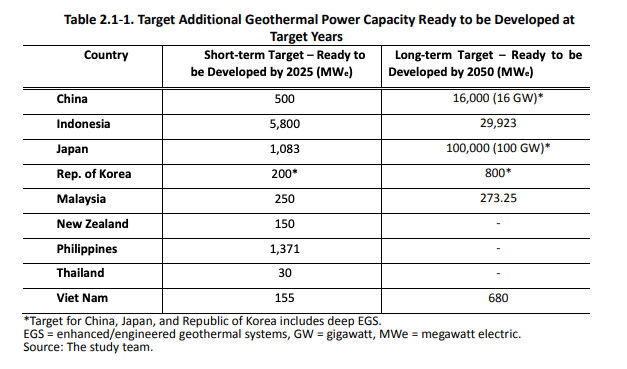What is needed to push geothermal development for power and direct use in Asia?
In a report released last week, the Economic Research Institute for ASEAN and East Asia (ERIA) provides a great overview on what innovations are needed for development of geothermal resources for power generation and direct use (as well as GSHP) in Asia.
The Economic Research Institute for ASEAN and East Asia has released an interesting report on the “Assessment on Necessary Innovations for Sustainable Use of Conventional and New-Type Geothermal Resources and their Benefits in East Asia.” The report was written by Kasumi Yasukawa and Venkatachalam Anbumozhi.
This report critically examines technical, social, policy, legal, and fiscal barriers to geo-thermal power production, direct use, and GSHP, and the estimated benefits in China, Indonesia, Japan, the Republic of Korea, Malaysia, the Philippines, Thailand, and Viet Nam.
The estimated benefits are multiple and vary across the countries. For example, with a target capacity factor of 70%, Indonesia is in a position save 232 billion barrels of oil, avoid 129 million tons of carbon emissions, and generate about 15,000 local jobs.
There are potential net benefits on a similar scale in the Philippines, Japan, China, and the Republic of Korea. Amongst the five types of barriers, it was found that technical and policy barriers dominate the Indonesian geothermal sector, while fiscal barriers are prevalent in the Philippines. Social barriers remain a challenge in Japan regarding direct use and GSHP.
Three main areas are recommended for immediate policy action.
- One, clarify precisely the role of each state entity in providing critical incentives and concessions at three different stages of geothermal power development.
- Second, the tariff setting and tax holidays for geothermal, direct use, and GSHP should be seen not as a one-time event, but as a process – based on a published methodology and stakeholder consultation.
- Third, the inability to develop new resources is often due to lack of information on the reserve capacity. More spending on research and development is recommended.
The report highlights the additional geothermal power capacity potential:

Here the targeted additional direct-use capacities:
The report provides a large list based on the different barriers to geothermal power development in the region: Policy, Social, Legal, Fiscal and Technical. Interesting is to see the evaluation for the individual countries and how things differ. While Japan clearly has the key issue of environmental matters and public acceptance, in the Philippines, the low selling price and high exploration cost are key issues. In Indonesia, the picture is a bit more diverse, where high exploration cost, lack of experts, lack of economic incentives, but also lack of info and experience are described as key issues.
It is rather interesting to see how this differs for power generation and direct use …
A rather interesting report with great details and information within. The report is available via the link provided below.